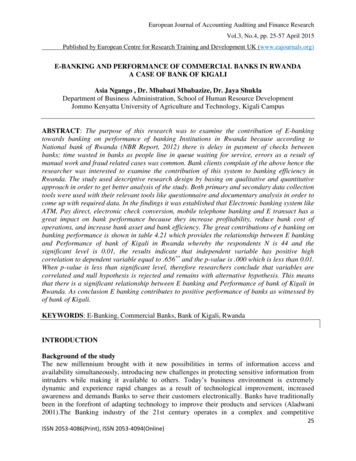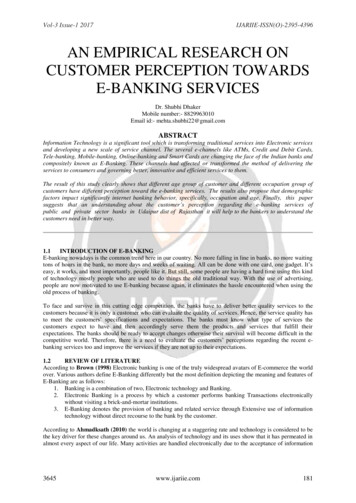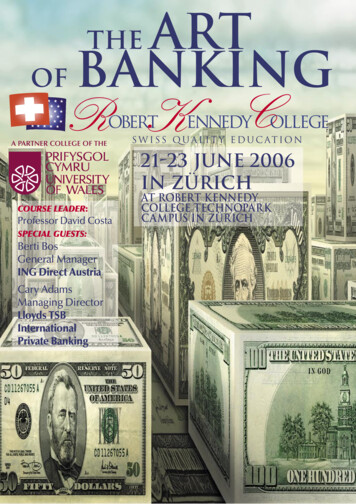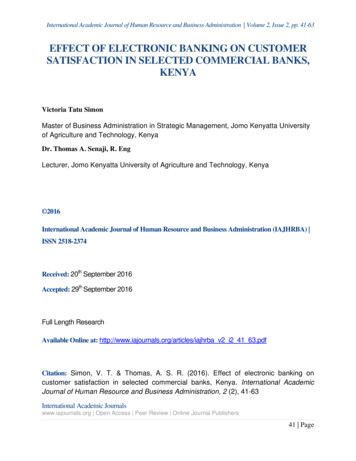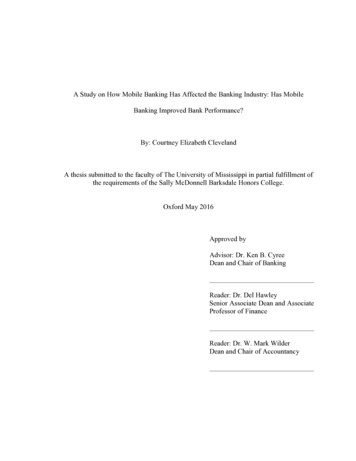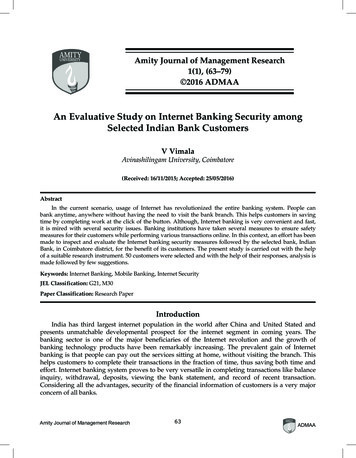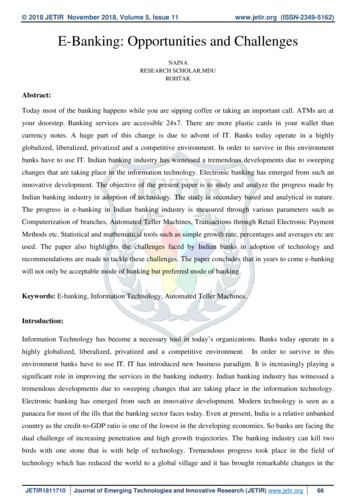
Transcription
2018 JETIR November 2018, Volume 5, Issue 11www.jetir.org (ISSN-2349-5162)E-Banking: Opportunities and ChallengesNAINARESEARCH SCHOLAR,MDUROHTAKAbstract:Today most of the banking happens while you are sipping coffee or taking an important call. ATMs are atyour doorstep. Banking services are accessible 24x7. There are more plastic cards in your wallet thancurrency notes. A huge part of this change is due to advent of IT. Banks today operate in a highlyglobalized, liberalized, privatized and a competitive environment. In order to survive in this environmentbanks have to use IT. Indian banking industry has witnessed a tremendous developments due to sweepingchanges that are taking place in the information technology. Electronic banking has emerged from such aninnovative development. The objective of the present paper is to study and analyze the progress made byIndian banking industry in adoption of technology. The study is secondary based and analytical in nature.The progress in e-banking in Indian banking industry is measured through various parameters such asComputerization of branches, Automated Teller Machines, Transactions through Retail Electronic PaymentMethods etc. Statistical and mathematical tools such as simple growth rate, percentages and averages etc areused. The paper also highlights the challenges faced by Indian banks in adoption of technology andrecommendations are made to tackle these challenges. The paper concludes that in years to come e-bankingwill not only be acceptable mode of banking but preferred mode of banking.Keywords: E-banking, Information Technology, Automated Teller Machines.Introduction:Information Technology has become a necessary tool in today’s organizations. Banks today operate in ahighly globalized, liberalized, privatized and a competitive environment.In order to survive in thisenvironment banks have to use IT. IT has introduced new business paradigm. It is increasingly playing asignificant role in improving the services in the banking industry. Indian banking industry has witnessed atremendous developments due to sweeping changes that are taking place in the information technology.Electronic banking has emerged from such an innovative development. Modern technology is seen as apanacea for most of the ills that the banking sector faces today. Even at present, India is a relative unbankedcountry as the credit-to-GDP ratio is one of the lowest in the developing economies. So banks are facing thedual challenge of increasing penetration and high growth trajectories. The banking industry can kill twobirds with one stone that is with help of technology. Tremendous progress took place in the field oftechnology which has reduced the world to a global village and it has brought remarkable changes in theJETIR1811710Journal of Emerging Technologies and Innovative Research (JETIR) www.jetir.org66
2018 JETIR November 2018, Volume 5, Issue 11www.jetir.org (ISSN-2349-5162)banking industry. Branch banking in the brick and mortar mode has been transformed into click and orderchannel mode.Review of Literature:A.J. Joshua, Moli P Koshy (2011), in this study majority of the respondents has computer and internetaccess and they are also mostly proficient in using them. The users of internet banking, tele-banking andmobile banking are in general found to be spending more hours using computers and internet than non-usersof these services. The hours of computer usage, the frequency of internet usage and hours of internetbrowsing were found to be significantly higher among users as compared to non-users of technologyenabled banking self service. It concludes that banks can target those customers whose usage of computers,internet and other technology products are relatively on the higher side.Trivedi & Patel (2013) analysed the problems faced by customers while using e-banking facilities in India.It observed that most of the customers know about the e-banking services offered by their bank. The studyfound that there is a significant difference amongst different problems identified while using e-bankingservices. It also found that some problems affect more and some problems affect less in use of bankingservices. It concluded that all the reasons are not equally responsible for not using e-banking services.Haq & Khan (2013) analysed the challenges and opportunities in the Indian Banking sector. The studyshowed that only 28 per cent banking clients were using internet banking after evaluating the populationcharacteristics. It found that there was no significant relationship in between age and use of cyber banking.It also depicted that there is no relation in between gender and the adoption of internet banking. It observedthat qualification in terms of education and income of the respondents were playing the role in theacceptance of online banking. The study suggested that it is the need of time that financial literacy of theusers should be increased through various programs which should be run by banks to increase the awarenessof internet banking.Vijayakumar Rajarathinam and Charndra Kumar Mangalam (2013), has indicate that users wereinfluenced by factors such as quick direct access, ease of use, anytime anywhere banking, status symbol,safety and security. The influence of the factors varied from the type of users. Consumers have differentlevels of competency in internet banking usage. The higher the consumers felt about their competency inhandling internet banking, higher was their frequency in usage of internet banking. Moderate and novice ofinternet banking users had relatively lesser levels of usage satisfaction.Objectives of the Study: To study the current status of financial innovations in Indian banking sector. To identify various e-banking services/products adopted by India.JETIR1811710Journal of Emerging Technologies and Innovative Research (JETIR) www.jetir.org67
2018 JETIR November 2018, Volume 5, Issue 11www.jetir.org (ISSN-2349-5162) To study the challenges faced in E-banking. To study the opportunities available in E-banking.E-Banking and its Evolution:E-Banking is the term that signifies and encompasses the entire sphere of technology initiatives that havetaken place in the banking industry. E-banking is a generic term making use of electronic channels throughtelephone, mobile phones, internet etc. for delivery of banking services and products. The concept and scopeof e-banking is still in the transitional stage. E-banking has broken the barriers of branch banking.E-banking came into being in UK and USA in 1920s. It became prominently popular during 1960s throughelectronic funds transfers and credit cards. The concept of web-based banking came into existence in Europeand USA in the beginning of 1980s. It has been estimated that around 40 percent of banking transactionwould be done through Net.E-Banking in India:In India e-banking is of fairly recent origin. The traditional model for banking has been through branchbanking. Only in the early 1990s there has been start of non-branch banking services. The good old manualsystems on which Indian Banking depended upon for centuries seem to have no place today. The credit oflaunching internet banking in India goes to ICICI Bank, Citibank and HDFC Bank followed with internetbanking services in 1999. Several initiatives have been taken by the Government of India as well as theReserve Bank to facilitate the development of e-banking in India. The Government of India enacted the ITAct, 2000 with effect from October 17, 2000 which provided legal recognition to electronic transactions andother means of electronic commerce. The Reserve Bank is monitoring and reviewing the legal and otherrequirements of e-banking on a continuous basis to ensure that e-banking would develop on sound lines ande-banking related challenges would not pose a threat to financial stability. A high level Committee underchairmanship of Dr. K.C. Chakrabarty and members from IIT, IIM, IDRBT, Banks and the Reserve Bankprepared the IT Vision Document- 2011-17, for the Reserve Bank and banks which provides an indicativeroad map for enhanced usage of IT in the banking sector. To cope with the pressure of growing competition,Indian commercial banks have adopted several initiatives and e-banking is one of them. The competition hasbeen especially tough for the public sector banks, as the newly established private sector and foreign banksare leaders in the adoption of e-banking.JETIR1811710Journal of Emerging Technologies and Innovative Research (JETIR) www.jetir.org68
2018 JETIR November 2018, Volume 5, Issue 11www.jetir.org (ISSN-2349-5162)Current Status of E-Banking in India:Internet Banking has become an integral part of banking system in India. The concept of e-banking is offairly recent origin in India. Till the early 90’s traditional model of banking i.e. branch based banking wasprevalent, but after that non-branch banking services were started. The credit of launching internet bankingin India goes to ICICI Bank. Citibank and HDFC Bank followed with internet banking services in 1999. TheGovernment of India enacted the IT Act, 2000 with effect from October 17, 2000 which provided legalrecognition to electronic transactions and other means of electronic commerce. The Reserve Bank ismonitoring and reviewing the legal and other requirements of e-banking on a continuous basis to ensure thate-banking would develop on sound lines and e-banking related challenges would not pose a threat tofinancial stability. According to report of RBI in January 2016, there are 1,96,079 ATM and 13,37,310 pointof sale devices in India. To cope with the pressure of growing competition, Indian commercial banks haveadopted several initiatives and e-banking is one of them. The competition has been especially tough for thepublic sector banks, as the newly established private sector and foreign banks are leaders in the adoption ofe-banking. Indian banks offer to their customers following e-banking products and services: Automated Teller Machines (ATMs) Electronic Clearing Services Internet Banking Electronic Clearing Cards Mobile Banking Smart Cards Phone Banking Door Step Banking Tele-banking Electronic Fund TransferThe Three Broad Facilities that E-banking offers are: Convenience - Complete your banking at your convenience in the comfort of your home. No more Qs - There is no queue at an online bank. 24x7 Service - Bank online services are provided 24 hours a day, 7 days a week and 52 weeks ayear.Opportunities in E-Banking: Untapped Rural Markets: Contributing to 70% of the total population in India is a largelyuntapped market for banking sector. In all urban areas banking services entered but only few bigvillages have the banks entered. So that the banks must reach in remaining all villages becausemajority of Indian still living in rural areas. Multiple Channels: Banks can offer so many channels to access their banking and other servicessuch as ATM, Local branches, Telephone/mobile banking, video banking etc. to increase thebanking business.JETIR1811710Journal of Emerging Technologies and Innovative Research (JETIR) www.jetir.org69
2018 JETIR November 2018, Volume 5, Issue 11 www.jetir.org (ISSN-2349-5162)Competitive Advantage: The benefit of adopting e-banking provides a competitive advantage to thebanks over other players. The implementation of e-banking is beneficial for bank in many ways as itreduces cost to banks, improves customer relation , increases the geographical reach of the bank, etc.The benefits of e-banking have become opportunities for the banks to manage their banking businessin a better way. Increasing Internet Users & Computer Literacy: To use internet banking it is very important orinitial requirement that people should have knowledge about internet technology so that they caneasily adopt the internet banking services. The fast increasing internet users in India can be a verybig opportunity and banking industry should encash this opportunity to attract more internet users toadopt internet banking services. Worthy Customer Service: Worthy customer services are the best brand ambassador for any bankfor growing its business. Every engagement with customer is an opportunity to develop a customerfaith in the bank. While increasing competition customer services has become the backbone forjudging the performance of banks. Internet Banking: It is clear that online finance will pickup and there will be increasingconvergence in terms of product offerings banking services, share trading, insurance, loans, based onthe data warehousing and data mining technologies. Anytime anywhere banking will becomecommon and will have to upscale, such up scaling could include banks launching separate internetbanking services apart from traditional banking services. Retail Lending: Recently banks have adopted customer segmentation which has helped incustomizing their product folios well. Thus retail lending has become a focus area particularly inrespect of financing of consumer durables, housing, automobiles etc., Retail lending has also helpedin risks dispersal and in enhancing the earnings of banks with better recovery rates.Challenges in E-Banking: Security Risk: The problem related to the security has become one of the major concerns for banks.A large group of customers refuses to opt for e-banking facilities due to uncertainty and securityconcerns. According to the IAMAI Report (2006), 43% of internet users are not using internetbanking in India because of security concerns. So its a big challenge for marketers and makesconsumers satisfied regarding their security concerns, which may further increase the online bankinguse. The Trust Factor: Trust is the biggest hurdle to online banking for most of the customers.Conventional banking is preferred by the customers because of lack of trust on the online security.They have a perception that online transaction is risky due to which frauds can take place. Whileusing e-banking facilities lot of questions arises in the mind of customers such as: Did transaction goJETIR1811710Journal of Emerging Technologies and Innovative Research (JETIR) www.jetir.org70
2018 JETIR November 2018, Volume 5, Issue 11www.jetir.org (ISSN-2349-5162)through? Did I push the transfer button once or twice? Trust is among the significant factors whichinfluence the customers’ willingness to engage in a transaction with web merchants. Customer Awareness: Awareness among consumers about the e-banking facilities and proceduresis still at lower side in Indian scenario. Banks are not able to disseminate proper information aboutthe use, benefits and facility of internet banking. Less awareness of new technologies and theirbenefits is among one of the most ranked barrier in the development of e-banking. Privacy Risk: The risk of disclosing private information & fear of identity theft is one of the majorfactors that inhibit the consumers while opting for internet banking services. Most of the consumersbelieve that using online banking services make them vulnerable to identity theft. According to thestudy consumers’ worry about their privacy and feel that bank may invade their privacy by utilizingtheir information for marketing and other secondary purposes without consent of consumers. Strengthening the public support: In developing countries, in the past, most e-finance initiativeshave been the result of joint efforts between the private and public sectors. If the public sector doesnot have the necessary resources to implement the projects it is important that joint efforts betweenpublic and private sectors along with the multilateral agencies like the World Bank, be developed toenable public support for e-finance related initiatives. Availability of Personnel Services: In present times, banks are to provide several services likesocial banking with financial possibilities, selective up gradation, computerization and innovativemechanization, better customer services, effective managerial culture, internal supervision andcontrol, adequate profitability, strong organization culture etc. Therefore, banks must be able toprovide complete personnel service to the customers who come with expectations. Implementation of Global Technology: An adequate level of infrastructure and human capacitybuilding is required before the developing countries can adopt global technology for theirrequirements. In developing countries, many consumers either do not trust or do not access to thenecessary infrastructure to be able to process e-payments. Non-Performing Assets (NPA): Nonperforming assets are another challenge to the banking sector.Vehicle loans and unsecured loans increases N.P.A. which terms 50% of banks retail portfolio wasalso hit due to upward movement in interest rates, restrictions on collection practices and soaringreal estate prices. So that every bank have to take care about regular repayment of loans. Competition: The nationalized banks and commercial banks have the competition from foreign andnew private sector banks. Competition in banking sector brings various challenges before the bankssuch as product positioning, innovative ideas and channels, new market trends, cross selling ad atmanagerial and organizational part this system needs to be manage, assets and contain risk. Banksare restricting their administrative folio by converting manpower into machine power i.e. banks areJETIR1811710Journal of Emerging Technologies and Innovative Research (JETIR) www.jetir.org71
2018 JETIR November 2018, Volume 5, Issue 11www.jetir.org (ISSN-2349-5162)decreasing manual powers and getting maximum work done through machine power. Skilled andspecialized man power is to be utilized and result oriented targeted staff will be appointed. Handling Technology: Developing or acquiring the right technology, deploying it optimally andthen leveraging it to the maximum extent is essential to achieve and maintain high service andefficiency standards while remaining cost effective and delivering sustainable return to shareholders.Early adopters of technology acquire significant competitive advances Managing technology istherefore, a key challenge for the Indian banking sector.Conclusion:With the time, the concept of internet banking has got attention in the Indian context. Most of the bankshave already implemented the e-banking facilities, as these facilities are beneficial to both i.e. banks as wellas consumers. The banks are facing many challenges and many opportunities are available with the banks.Many financial innovations like ATMs, credit cards, RTGS, debit cards, mobile banking etc. havecompletely changed the face of Indian banking. Thus, there is a paradigm shift from the seller's market tobuyer's market in the industry and finally it affected at the bankers level to change their approach from"conventional banking to convenience banking" and "mass banking to class banking". The shift has alsoincreased the degree of accessibility of a common man to bank for his variety of needs and requirements. Inyears to come, e-banking will not only be acceptable mode of banking but will be preferred mode ofbanking.References:1. dJanuary20,2015,http://www.iba.org.in/oltas.asp2. ICICI Bank Website, “ICICI bank launches, Pocket by ICICI bank”, Accessed January 25, ibank-launches-pockets-by-icicibank.html3. Business Today (2014, April 5), “Now, Access Your SBI Account via Twitter”, Accessed 8.html4. Prema C, “A framework for understanding consumer perceived characteristics of internet banking aspredictors of its adoption”, Indian Journal of Marketing, Vol. 41, No. 2, (2011): pp. 46-53.5. Kuisma T, Laukkanen T and Hiltunen M, “Mapping the reasons for resistance to internet banking: Ameans-end approach”, International Journal of Information Management, Vol. 27 No. 2, (2007): pp.75–85.JETIR1811710Journal of Emerging Technologies and Innovative Research (JETIR) www.jetir.org72
2018 JETIR November 2018, Volume 5, Issue 11www.jetir.org (ISSN-2349-5162)6. Littler D and Melanthiou D, “Consumer perceptions of risk and uncertainty and the implications forbehaviour towards innovative retail services: The case of internet banking”, Journal of Retailing andConsumer Services, Vol. 13No. 6, (2006): pp. 431–43.7. Ingle A and Pardeshi R, “Internet Banking in India: Challenges and Opportunities”, IBMRD'sJournal of Management and Research, Vol. 1,(2012): pp. 13-18.8. Yousafzai S Y, Pallister J G and Foxall G R, “A proposed model of e-trust for electronic banking”,Technovation, Vol. 23, (2003): pp.847–860.9. Karimzadeh M and Alam D, “Electronic banking challenges in India: An empirical investigation”,Interdisciplinary Journal of Contemporary Research in Business, Vol. 4 No. 2, 2012): pp. 31-45JETIR1811710Journal of Emerging Technologies and Innovative Research (JETIR) www.jetir.org73
E-banking is a generic term making use of electronic channels through telephone, mobile phones, internet etc. for delivery of banking services and products. The concept and scope of e-banking is still in the transitional stage. E-banking has broken the barriers of branch banking. E-banking came into being in UK and USA in 1920s.
